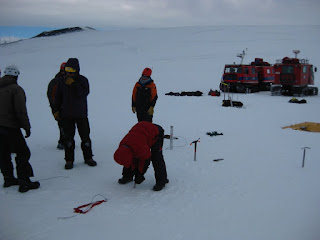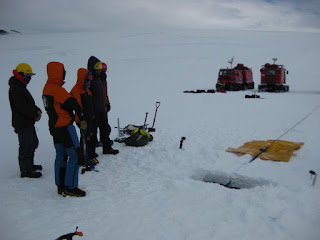11/7/18
I got selected to be on the Antarctic search and rescue team. I'm excited for the opportunity because it's an honor, I'll get to learn some great skills, and help out the community. Search and Rescue is used anytime someone gets lost or there is an accident off of station. Some examples of recent search and rescues were scientists lost on Mt. Discovery, extraction of someone who fell in a crevasse, search for the location of a crashed plane. So we're basically trained in many Antarctic rescue situations. In the case of an emergency, we are all paged, we grab our gear, and then load onto either a helicopter or twin otter to fly to where the search or rescue needs to happen
We had our first meeting last night where we were issued all of our gear: technical outerwear, big puffy coats and puffy pants, sleeping bags, mountaineering boots, crampons, snow stakes, ice axes, ice screws, snow saws, shovels, harnesses, ropes, climbing gear, radios, etc.
Tonight was also the first night of volleyball, so excited to be back into that. Basketball started last week, so we are back into the swing of things with sports. Mitch is still leading insanity and beach body workouts which we have affectionately coined Mitchbody, Body by Mitch, or Mitchsanity.
11/8/18
I had a full day of SAR practice. We spent most of the day outside near the crevasse simulator learning about anchor theory and doing pull tests for various anchors (pickets, deadmans, snow stakes), then we spent some time in the classroom learning about knots. One of the coolest parts was getting to drive in the new hagglunds. They're such cool vehicles. They can climb crazy steep slopes, go on high angled slopes without rolling, and can even float in water in the event you break through the ice.They're equipped with all kinds of radar for traveling in zero visibility conditions.
I got selected to be on the Antarctic search and rescue team. I'm excited for the opportunity because it's an honor, I'll get to learn some great skills, and help out the community. Search and Rescue is used anytime someone gets lost or there is an accident off of station. Some examples of recent search and rescues were scientists lost on Mt. Discovery, extraction of someone who fell in a crevasse, search for the location of a crashed plane. So we're basically trained in many Antarctic rescue situations. In the case of an emergency, we are all paged, we grab our gear, and then load onto either a helicopter or twin otter to fly to where the search or rescue needs to happen
We had our first meeting last night where we were issued all of our gear: technical outerwear, big puffy coats and puffy pants, sleeping bags, mountaineering boots, crampons, snow stakes, ice axes, ice screws, snow saws, shovels, harnesses, ropes, climbing gear, radios, etc.
Tonight was also the first night of volleyball, so excited to be back into that. Basketball started last week, so we are back into the swing of things with sports. Mitch is still leading insanity and beach body workouts which we have affectionately coined Mitchbody, Body by Mitch, or Mitchsanity.
11/8/18
I had a full day of SAR practice. We spent most of the day outside near the crevasse simulator learning about anchor theory and doing pull tests for various anchors (pickets, deadmans, snow stakes), then we spent some time in the classroom learning about knots. One of the coolest parts was getting to drive in the new hagglunds. They're such cool vehicles. They can climb crazy steep slopes, go on high angled slopes without rolling, and can even float in water in the event you break through the ice.They're equipped with all kinds of radar for traveling in zero visibility conditions.
 |
| the 2 brand new Hagglund rescue vehicles |
 |
| doing pull tests on snow anchors |
 |
| building snow anchors |
 |
| pull test of a deadman anchor |
 |
| Add caption |
 |
| Hagglund and Pisten Bully parking lot |
 |
| Add caption |
 |
| Add caption |


No comments:
Post a Comment